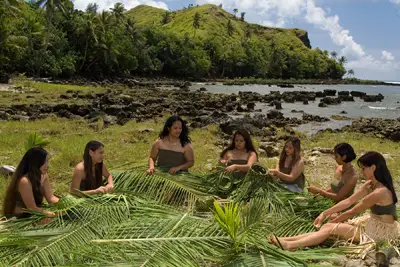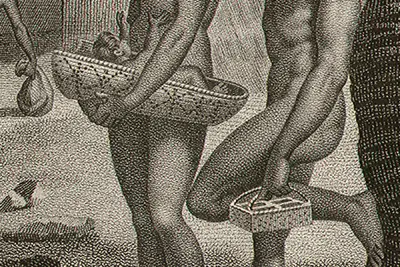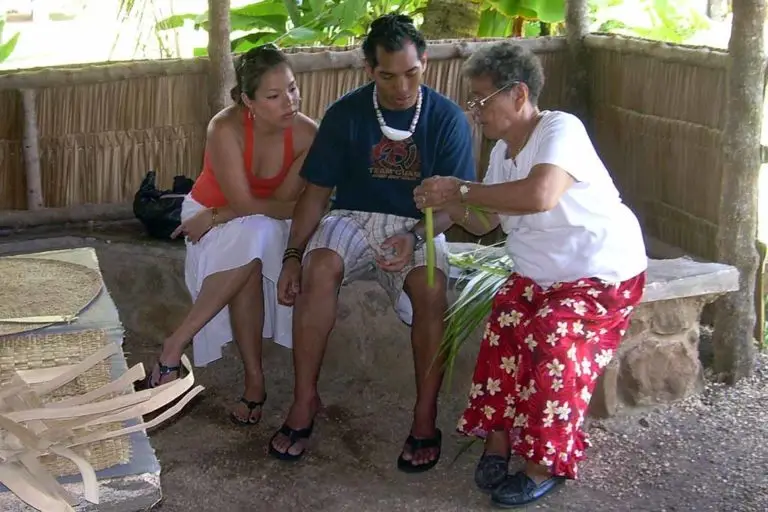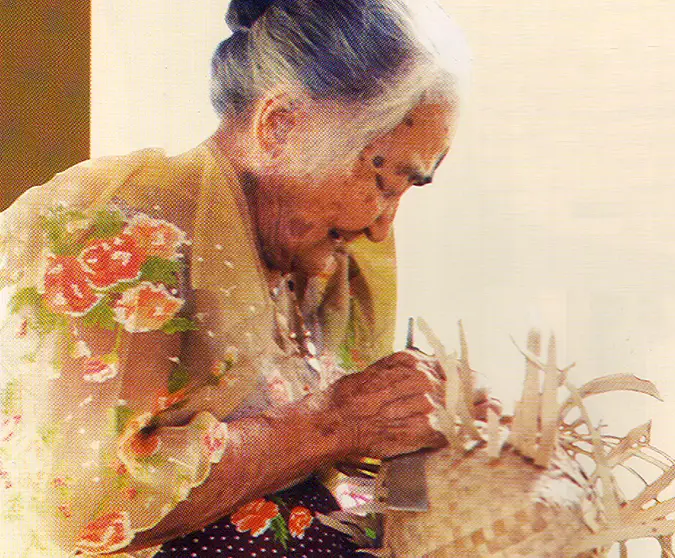Weaving




Table of Contents
Share This
Lasting CHamoru/Chamorro artistry
Weaving continues to be an important practice on Guam. For thousands of years CHamorus/Chamorros have used Guam’s abundant foliage to produce useful and unique items. Although the art of weaving is not as prevalent on Guam today as it has been in days gone by, or as critical for everyday life, it is still seen as one of the lasting artistries of CHamoru culture.
Utilitarian weaving and artistry
In ancient CHamoru society women completed the majority of the household tasks including most of the weaving. They used various leaves and palms to create items for everyday life including mats, sails, hats, baskets, bags and decorative pieces.
Many pieces were created from the same material but served different purposes. For example, a mat woven out of pandanus leaves, or akgak, could be used for sleeping, blankets, funeral preparations, food serving platters or cloths to clean surfaces.
Typical, everyday woven items included mats, boxes and hats. Rectangular baskets (kottot) were used for presenting gifts of rice. Smaller boxes, some equipped with handles (alan mamao) or complex latches (saluu), were used to carry betel nut. CHamorus wove bags with lids (balakbagk) equipped with straps to carry items at waist level. There were also larger woven cases (hagug) used like a backpack for carrying provisions and food.
In addition to the many types of woven bags, CHamorus also wove mats, plates and even cradles from leaves. The CHamoru basket weave is noted for its strength provided by a double rim.
Some woven items were more decorative than practical. Many weavers excelled at artistic creations including birds, shrimp, headbands and floral arrangements. Many of these items were created using a weaving tool known as a si’i. The tool is a piece of flat, triangular-shaped metal that measures roughly six inches.
Ancient CHamorus also used their weaving skills to create fish nets (talaya), traps and slings but less is known about these practices. Some sources indicate the ancient society used bark from the wild hibiscus (pagu) tree or bamboo for nets and traps. Some weavers also incorporated coconut husk fibers into rope and bamboo needles and gauges when weaving fishing nets. Slings were typically made from pandanus leaves.
Weaving techniques
The pandanus plant (Pandanus tectorius) is native to Guam and provides fibrous leaves that are good for weaving. The wide leaves grow low to the ground, making them easy to reach by women collecting weaving materials.
The pandanus leaf is typically prepared by cutting it from the plant and by using a si’i, a small cutting tool, to remove the hard, sharp thorns along the edge of the leaf. After the thorns are removed, the leaves are boiled and scraped with a shell before being dried in the sun. The dried leaves are rolled up and kept inside for a few days. Finally the leaves are left out in the sun for weeks where they are cured and readied for use. Before using the cured pandanus leaf for weaving, the weaver would drag a shell-tool across the surface of the leaf to make it more pliable.
Other plants found in abundance on Guam, coconut and nipa palm fronds, were also used for weaving materials. Both of these trees are found anywhere on island, although the former is more common. Typically younger leaves were best for basket. They were left in the sun to cure before use.
Thatching and trap making
Sturdier leaves from the coconut or nipa palm, were used for roof thatching on traditional CHamoru huts. Nipa thatch was preferable because it lasted roughly five years compared to coconut thatch’s two-year lifespan. Nipa and pandanus leaves can last up to eight years as thatching over bamboo slats.
When preparing leaves for thatching the fronds are typically collected in the drier months. Dry season falls in the beginning of the calendar year on Guam. Once harvested, the fronds are split down the middle. The two spines are then placed on top of one another and the leaves are woven using diagonal plaiting to make a piece of thatch. The pieces are tied together and dried before being placed on the roof of the home.
Another utilitarian form of weaving is trap making. Many times traps were made from bamboo that has been heated over hot charcoal and then stretched into the proper shape. Traps can also be made from coconut leaves.
Contemporary weaving and culture
Although many woven items have been replaced with modern manufactured items in contemporary Guam, weavers continue to produce mats, bags, novelty items and decorative pieces that are either used locally or sold to tourists.
One of the most popular areas on Guam to watch and learn weaving is at Gef Pa’go, Inajaran, a cultural demonstration center in Southern Guam. Gef Pa’go employs several master weavers who demonstrate the art to students, tourists and interested residents. The Gef Pago cultural village area also has a small gift shop featuring woven creations by the masters employed there. The gift shop sells small woven animals, fish and utilitarian pieces created out of dried palm leaves.
Many of the masters working at Gef Pa’go and around the island learned to weave from family members or others living in their village when woven items were crucial to every day life. The tradition was not encouraged by the Japanese during the occupation of World War II but resurfaced after the liberation of Guam in 1944.
Although the practice of weaving continued after the war, the number of island residents that regularly wove began to dwindle as modern items became more available and replaced items had been woven in the past. In turn, the number of island residents who knew the art of weaving also began to dwindle.
In recent years, however, weaving is increasingly being seen as more of a cultural reminder and decorative art rather than an essential practice for everyday life. Weavers continue to make decorative items for local parties, fiestas, gatherings or displays. Decorations typically include hanging pieces, table centerpieces, palms woven in a vertical manner to create a divider are often seen.
Weavers are also beginning to transform the practice into more of an art medium. For example, woven leaves are now being used as a medium for sculpting.
For further reading
A Journey with the Masters of Chamorro Tradition. Hagåtña: Guam Council on the Arts and Humanities Agency, 2000.
Cunningham, Lawrence J. Ancient Chamorro Society. Honolulu: Bess Press, 1992.
Flores, Judy. “Art and Identity in the Mariana Islands: Issues of Reconstructing an Ancient Past.” PhD thesis, University of East Anglia, 1999.
